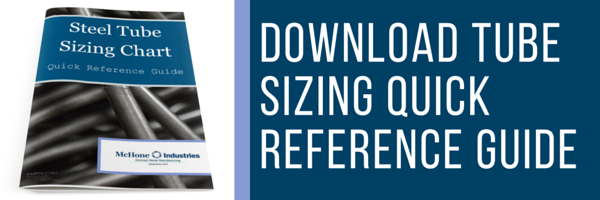We've all heard about how great stainless steel is. It's durable, attractive, and lightweight.
But what about other types of steel? What if you can't afford stainless, or don't care about aesthetics or weight? If your main concerns include durability, strength, and affordability, carbon steel tubing (often called mild steel tubing) may be more appropriate for you.
Let's talk about high-carbon steel disadvantages and advantages when it comes to tubular components.
Carbon Steel Tubing v. Other Steels
Carbon steel is made of a steel alloy of iron and carbon. The high amount of carbon gives carbon steel its familiar dark color. Steel with a percentage of carbon over 2% is considered cast iron.
Stainless steel is an alloy made with chromium, which is what makes it so shiny. Stainless steel can have many other elements mixed in (such as nickel and titanium) depending on its intended application.
Mild steel is a type of carbon steel, though its carbon percentage is incredibly low (only about 0.2%). So, the two extreme ends of the carbon steel spectrum are low-carbon mild steel and high-carbon cast iron.
Carbon Tubular Steel Benefits
Affordable
Due to high-carbon steel's naturally high strength, a little material goes a long way. The less base material you need, the more affordable your project will be. The base materials of carbon steel -- iron and carbon -- are also much cheaper than the alloys in stainless steel.
Further, carbon steel doesn't need to be replaced frequently, which saves money on repairs and replacement components.
Environmentally Friendly
Carbon steel, like other steels, is highly recyclable (more steel is recycled than glass, plastic, paper, and aluminum products combined). 70% of all steel gets recycled after use, which equates to more than 80 million tons of steel recycled every year in North America.
Highly Durable
Carbon steel is popular in infrastructure and construction applications due to its high durability. It's non-combustible, resistant to harsh weather and changes in pressure, and resistant to shock.
Vibration and shock must be considered when designing highly trafficked infrastructure like roads. Carbon steel is the perfect material for laying under roads, as it will not be damaged under the shock of traffic.
High Strength
Carbon steel has a naturally high tensile strength, which means it's difficult to bend and break. Due to this strength, carbon steel tubing can be thinner while transporting higher amounts of materials at a higher pressure.
Carbon Steel Tubing Disadvantages
Brittle
Due to the high carbon content, carbon steel is very hard and brittle compared to other metals. This means it's less likely to bend under pressure, but it has a higher chance of snapping or breaking.
Unattractive
Carbon steel isn't nearly as attractive as stainless -- if you need a highly aesthetic metal, carbon steel is not the material for you.
Heavy
Carbon is a heavy, dense metal. Even though manufacturers can produce relatively thin carbon steel tubes, they remain heavy due to their elemental makeup.

Common Carbon Steel Tubing Applications
Due to its hardness, strength, and shock resistance, carbon steel is used most often in industrial applications. Here are the most common uses for carbon steel tubing:
-Industrial machinery, tools, and structures
-Power plants
-Ship building
-Water mains under roads
-Building, construction, infrastructure
-High-pressure fluid transportation
-Metal & wood cutting tools
Though it falls short in some categories compared to stainless steel, you shouldn't ignore the benefits of carbon steel. It can withstand violent conditions, it's highly affordable, and it's environmentally friendly.
Contact us to learn more about carbon steel tubing advantages and what it can do for you.


